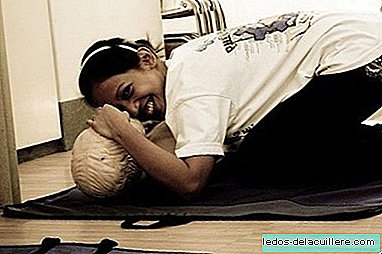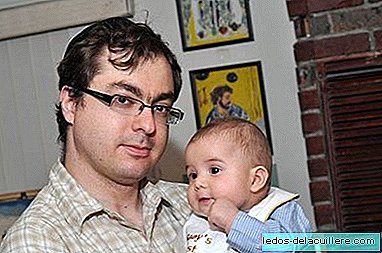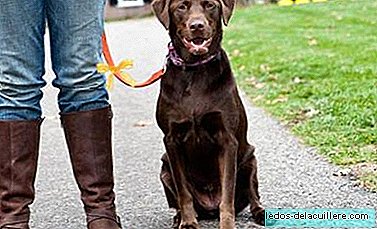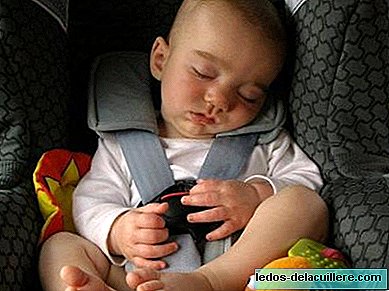
If the baby suffers a cardiorespiratory arrest, we already have the basic notions about what we have and the first steps to be taken to ensure that emergency services arrive as soon as possible. We continue now with the way of providing first aid to perform cardiopulmonary resuscitation of a baby, where we will have to use ourselves thoroughly to try to revive him.
In 2010 the new CPR GUIDE of the American Heart Association was published, an entity that sets the standard in the rest of the world for these first aid: "2010 American Heart Association Guidelines for Cardiopulmonary Resuscitation and Emergency Cardiovascular Care Science".
The main difference from previous protocols is that it marks the need to give absolute priority to resuscitation with compressions only to facilitate a rapid and effective cardiopulmonary resuscitation (CPR), leaving air insufflations (mouth-to-mouth or mouth-to-nose breaths in the case of babies) in a second place.
It is often said that the protocols of action for CPR last five years, and this issue is changing from time to time in the light of new scientific research, so we will remain attentive to new changes in the future.
Prepare the baby's cardiopulmonary resuscitation
The baby must be placed on a flat and hard surface (if it can be not directly on the floor, that is, on a blanket or thin carpet to keep the body heat better). If we suspect that the baby has neck injuries we should be very careful in the movements and move it immobilized. The infant should be placed on his back and with the head, neck, trunk and limbs aligned.
We will raise the baby's head with the "front-chin maneuver": to ensure the opening of the airways (the tongue is rolled back with this movement, leaving free the respiratory passage that could otherwise be blocked by the tongue "back") we will rest a hand on the forehead to tilt the head back , and two fingers of the other hand on the chin to raise the chin.
If we suspect cervical injury we should simply push the jaw forward without moving the head and neck, which is known as the "jaw lift" maneuver. The resuscitator places two or three fingers on both sides of the lower jaw at the angle and lifts the jaw up and out, without hyperextended or rotating the neck. In no case should we allow the mouth to close.

Cardiac massage to a baby
As we have said in the introduction, the old protocols indicated that the first maneuver should be that of breathing, but currently (since 2010) priority is given to cardiac massage. Therefore, cardiopulmonary resuscitation begins with compressions. Effective chest compressions are essential to produce blood flow during resuscitation.
Cardiac massage in babies It is done with two fingers on the baby's sternum, approximately below the imaginary line that joins the two nipples.
We can calculate the exact place as follows. The index finger of the resuscitator's hand is placed in the sternum, just below the intermammary line, the middle and ring fingers are located next to the index finger; The index finger is lifted and the sternal compression is performed using the middle and ring fingers. The compression of the xiphoid appendages, which is the lowest area of the sternum, should also be avoided.
In short, chest compressions in the infant should be performed on the lower third of the sternum, pressing right in the center and must be firm, intense, that we perceive that the sternum falls a few centimeters, taking care that there is no lateral displacement because We could break a baby rib.
The other hand of the resuscitator can be used to maintain the position of the infant's head (unless that hand is under the back). This allows ventilation to be given without repositioning the head. In any case, there are different techniques, so we list the recommendations of pediatric cardipulmonary resuscitation guidelines of the year 2005.
In infants and newborns cardiopulmonary massage It can be done in the following ways:
Covering the thorax with both hands: the thumbs will be placed on the lower third of the sternum and the sternum will be compressed while the thorax is covered with the rest of the fingers. Compress the sternum with both thumbs. This technique is more effective and is indicated when there are two resuscitators and the resuscitator can cover the chest between your hands.
With two fingers, the mechanism indicated above: the middle and ring fingers will be placed in the lower third of the sternum. With the fingertips the sternum will be depressed approximately 1/3 of the depth of the thorax. This technique is preferable when there is only one resuscitator.
You have to do 30 cardiac compressions, at a rapid pace and without pause (there are 100 every minute, that is, 30 compressions in about 18 seconds), better counting out loud, and let the sternum rise between one compression and another, without removing the fingers of the baby's body, but without pressing (we would have to be constantly looking for the right place to press).
After the first cardiac compressions, the baby must be breathed in as detailed below.

Breathing mouth - mouth nose
The resuscitation maneuver continues with two air insufflations to the baby (Although there are rules that indicate that there should be five insufflations), slightly raising the baby's chin, and covering with his mouth his mouth and nose (in adults it is done mouth to mouth, but this is impossible on the small face of the baby).
In this way, we will introduce air into the baby's lungs through his nose and mouth through a deep and long insufflation (if we do it correctly, we will observe some elevation of the chest).
Every 30 compressions will proceed to two air insufflations, and these procedures should be continued until the baby's heartbeat and breathing return or trained medical personnel arrive.
If there is more than one person attending to the baby, the ideal is to take turns every two or three minutes, about five cycles (30 compressions, 2 breaths for five) to regain strength and avoid exhaustion.
We do not know if we can get the baby out of the stop, but our maneuver will cause the blood to circulate and oxygenate the baby's organism, to prevent it from rapidly deteriorating as would happen if we remain motionless, a situation in which probably, depending on what they take Emergency services, there would be nothing left to do.
We hope that these notions about first aid and how to perform a cardiopulmonary resuscitation of a baby You have been interesting. And that in the case you never wanted to meet a situation that requires the resuscitation of a baby you can follow these fundamental steps to save the child's life.












